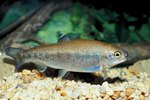Fish release ammonia as part of a natural biological process. Having too many fish in a tank or feeding too often can cause high levels of ammonia, which can be deadly. To determine whether high ammonia levels are the cause of a fish die-off, you will need to test the tank water. Measuring ammonia in fish tanks is easy using test kits sold at fish stores.
Use an ammonia test strip kit for quick results. Dip the test strip into the water for about 10 seconds. Remove the test strip and compare it to the color chart on the bottle. By closely matching the color on the strip to the color chart, you will have an estimate of ammonia levels in the tank.
Use a salicylate ammonia test for more accurate results. To use this test, collect a water sample in the test tube provided and add a measured amount of chemical drops, which are also included with the test. Mix the chemicals and wait the allotted time for the color to change. Then match the color to the kit’s color chart for results. Follow the test kit's instructions for how many drops to use from each of the chemicals provided.
Test the tank every couple of days if you are working to bring ammonia levels down. This will help you learn what is affecting the ammonia levels in your tank.
References
Photo Credits
-
BananaStock/BananaStock/Getty Images
Writer Bio
Lynn Anders has more than 15 years of professional experience working as a zookeeper, wildlife/environmental/conservation educator and in nonprofit pet rescue. Writing since 2007, her work has appeared on various websites, covering pet-related, environmental, financial and parenting topics. Anders has a Bachelor of Arts in environmental studies and biology from California State University, Sacramento.




